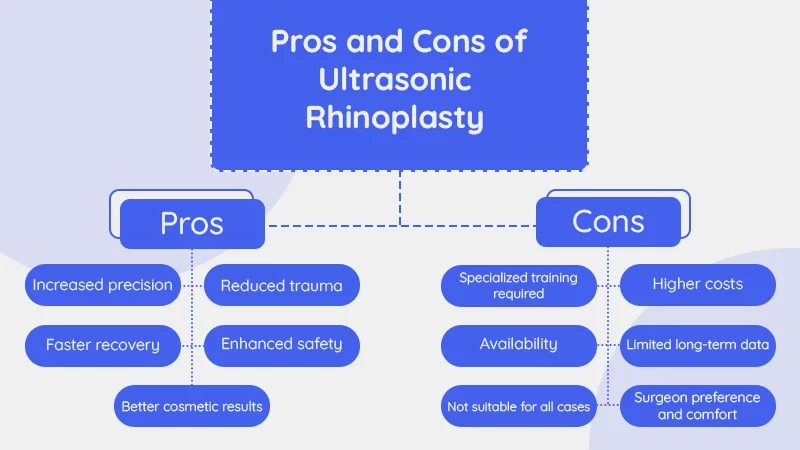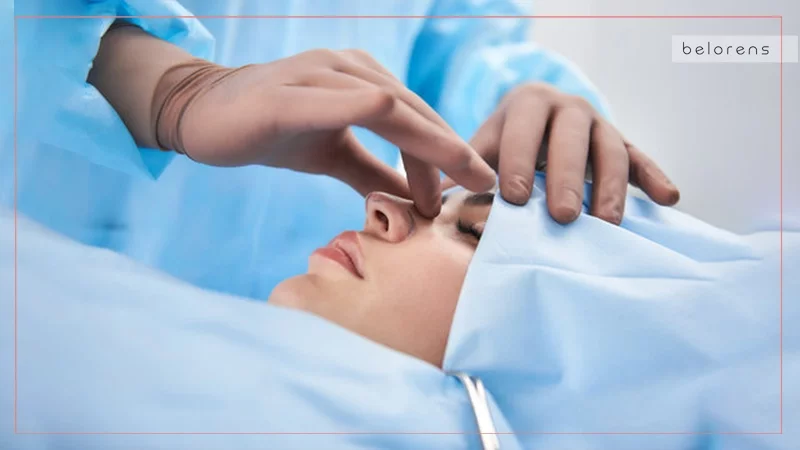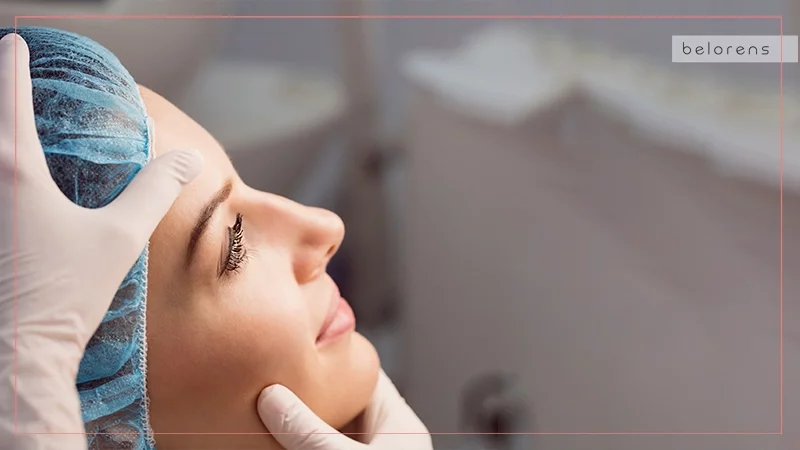Published on 17 July 2024
Ultrasonic Rhinoplasty: Everything You Need to Know?
- ByMedical Content Team
- Medically Reviewed byDr. Sabine Kulhanek
Fact checked

- What is ultrasonic rhinoplasty?
- How ultrasonic rhinoplasty differs from traditional rhinoplasty
- Pros and cons of ultrasonic rhinoplasty
- Who is a good candidate for ultrasonic rhinoplasty?
- Is ultrasonic rhinoplasty performed using open or closed approach?
- How common is ultrasonic rhinoplasty?
- Is ultrasonic rhinoplasty more expensive?
- Does ultrasonic rhinoplasty have specific risks?
In the ever-evolving field of cosmetic surgery, advancements continually reshape how procedures are performed and experienced. Among these innovations, ultrasonic rhinoplasty has emerged as a notable technique that offers a different approach to nasal surgery compared to traditional methods. This procedure leverages ultrasonic technology to potentially provide more precision and control during surgery.
As with any medical advancement, ultrasonic rhinoplasty brings both its unique benefits and considerations. While it aims to reduce trauma to surrounding tissues and possibly shorten recovery times, it's important to examine this technique in a balanced manner, understanding its capabilities, limitations, and how it compares to established rhinoplasty methods.
In this blog post, we'll explore the fundamentals of ultrasonic rhinoplasty, detailing how the procedure works, its potential advantages, and any associated risks. We'll also provide a comparison with traditional rhinoplasty, helping you to make an informed decision if you're considering nasal surgery.
What is ultrasonic rhinoplasty?
Ultrasonic rhinoplasty, sometimes referred to as piezo rhinoplasty, is an advanced surgical technique for reshaping the nose, utilizing high-frequency ultrasonic waves to precisely cut and sculpt nasal bones and tissues. This method represents a modern evolution in rhinoplasty, offering an alternative to traditional techniques that typically involve manual tools like chisels and hammers.
Ultrasonic rhinoplasty employs a specialized device called a piezoelectric instrument, which generates ultrasonic vibrations. These vibrations allow the surgeon to meticulously sculpt the nasal bones and cartilage with high precision. The key feature of this technology is its ability to selectively target bone and hard cartilage while sparing the surrounding soft tissues, blood vessels, and mucous membranes from damage.
How ultrasonic rhinoplasty differs from traditional rhinoplasty
Ultrasonic rhinoplasty is a technique for performing rhinoplasty, rather than an entirely different procedure. Rhinoplasty, commonly referred to as a "nose job," is a surgical procedure aimed at reshaping the nose for either aesthetic or functional reasons. There are various techniques that surgeons can employ to perform this procedure, and ultrasonic rhinoplasty is one such technique.
Traditional rhinoplasty techniques
In traditional rhinoplasty, surgeons use manual tools such as scalpels, chisels, rasps, and hammers to reshape the nasal bones and cartilage. This method relies heavily on the surgeon’s skill and tactile feedback. The primary goal is to achieve the desired shape and function of the nose, but the process can involve significant trauma to the surrounding tissues, leading to more bruising and swelling and a longer recovery period.
The ultrasonic technique
Ultrasonic rhinoplasty, on the other hand, uses a specialized device that employs ultrasonic waves to precisely cut and sculpt the nasal bones and cartilage. This device, known as a piezoelectric instrument, allows for more controlled and accurate bone reshaping. It selectively targets hard tissues while sparing the surrounding soft tissues, blood vessels, and mucous membranes. The key benefits of this technique include reduced trauma, less bruising and swelling, and potentially shorter recovery times.
Similarities and differences
While both traditional and ultrasonic techniques aim to achieve the same end result—reshaping the nose—the methods and tools used differ significantly. Piezo rhinoplasty is not a separate type of surgery but rather an advanced method within the broader category of rhinoplasty techniques. It enhances the precision of the procedure and improves patient outcomes in certain cases.
Pros and cons of ultrasonic rhinoplasty

Ultrasonic rhinoplasty has its unique advantages and limitations. The choice of this technique depends on the patient’s specific needs, anatomical considerations, and desired outcomes. Here are the pros and cons of piezo rhinoplasty:
Pros
- Increased precision: The use of ultrasonic waves allows for highly precise cutting and sculpting of nasal bones and cartilage. This precision can result in more accurate and symmetrical outcomes.
- Reduced trauma: Ultrasonic instruments selectively target hard tissues, minimizing damage to surrounding soft tissues, blood vessels, and mucous membranes. This leads to less bruising and swelling compared to traditional methods.
- Faster recovery: Because the technique causes less trauma to the nasal tissues, patients often experience a shorter recovery period with reduced post-operative discomfort.
- Enhanced safety: The controlled nature of the ultrasonic device can reduce the risk of complications such as excessive bleeding and unintended damage to the nasal structure.
- Better cosmetic results: The precision and reduced trauma can contribute to more refined and natural-looking outcomes, potentially reducing the need for revision nose surgeries.
Cons
- Specialized training required: Surgeons need specific training and experience to effectively use ultrasonic devices. This can limit the number of surgeons who offer this technique.
- Higher costs: The specialized equipment required for ultrasonic rhinoplasty is expensive. This can increase the overall cost of the procedure for patients, making it less accessible.
- Availability: Not all clinics and surgical centers are equipped with the necessary piezoelectric instruments. As a result, the availability of ultrasonic rhinoplasty may be limited in certain areas.
- Limited long-term data: While promising, ultrasonic rhinoplasty is a relatively newer technique. There is less long-term data available on its outcomes and potential complications compared to traditional methods.
- Not suitable for all cases: Ultrasonic rhinoplasty may not be the best option for every patient or every type of nasal correction. Some complex cases requiring extensive cartilage work or structural changes might still benefit from traditional techniques.
- Surgeon preference and comfort: Many experienced rhinoplasty surgeons may prefer traditional methods with which they are more familiar and confident, potentially leading to varied outcomes based on the surgeon's skill and comfort level with the technology.
Who is a good candidate for ultrasonic rhinoplasty?
Candidates for ultrasonic rhinoplasty are typically individuals in good overall health who are non-smokers or willing to quit smoking before and after surgery. This technique is particularly beneficial for those with clear nasal structure issues such as a pronounced nasal hump, a deviated septum, or nasal asymmetry. Candidates should have good skin quality, with sufficient elasticity and thickness, which can lead to better outcomes. Ideal candidates for ultrasonic rhinoplasty are usually adults whose facial growth is complete, typically around 18 years old, although older candidates in good health can also benefit.
Those who require extensive cartilage work or significant structural changes to their nose are not ideal candidates for ultrasonic techniques and are better suited for traditional surgery, which is the preferred choice for complex cases. This method may also be more appropriate for patients with poor skin quality or those with extensive previous nasal surgeries, where the anatomy might present more challenges.
The choice between ultrasonic and traditional rhinoplasty depends on individual needs, anatomical considerations, and desired outcomes. Ultrasonic rhinoplasty is ideal for patients seeking precise bone work with minimal trauma and faster recovery, while traditional rhinoplasty remains versatile and suitable for more complex cases or those seeking a more cost-effective option. Consulting with a qualified and experienced surgeon is crucial to determine the most appropriate technique for achieving optimal results based on the patient’s specific situation.
Is ultrasonic rhinoplasty performed using open or closed approach?
Ultrasonic rhinoplasty can be performed using both the open and closed approaches, depending on the specific needs of the patient and the surgeon's preference.
Open ultrasonic rhinoplasty
Open ultrasonic rhinoplasty is a surgical technique that combines the open approach of rhinoplasty with the precision of ultrasonic (piezoelectric) technology. This method provides enhanced visibility and access to the nasal structures while leveraging advanced ultrasonic tools for precise bone and cartilage sculpting.
The open approach involves making an incision across the columella, the tissue between the nostrils, providing the surgeon with better visibility and access to the underlying nasal structures. This method is particularly beneficial for complex nasal reshaping and structural adjustments
Ultrasonic devices, or piezoelectric instruments, are used to emit high-frequency ultrasonic waves. These waves precisely cut and reshape the nasal bones and cartilage, minimizing damage to surrounding soft tissues and blood vessels. This precision reduces trauma, leading to less bruising and swelling.
Closed ultrasonic rhinoplasty
Closed ultrasonic rhinoplasty, also known as endonasal ultrasonic rhinoplasty, is a refined surgical technique that combines the principles of closed rhinoplasty with the advanced technology of piezoelectric devices. This method allows for precise nasal reshaping while minimizing external incisions and trauma.
In closed ultrasonic rhinoplasty, all incisions are made inside the nostrils, leaving no visible external scars. This approach provides a less invasive option with reduced healing time and less post-operative discomfort.
The use of piezoelectric (ultrasonic) devices in this technique is crucial. These devices operate by emitting high-frequency ultrasonic waves that precisely cut and reshape nasal bone and cartilage without damaging surrounding soft tissues. The selective action of these ultrasonic waves allows for meticulous sculpting of the nasal structures, which is particularly advantageous in the confined space of closed rhinoplasty.
Read More: Open vs Closed Rhinoplasty: Everything You Need to Know
How common is ultrasonic rhinoplasty?

While ultrasonic rhinoplasty offers notable benefits such as increased precision and reduced discomfort and downtime, it is not yet as widely adopted as traditional methods. Several factors contribute to this trend.
One major reason is the learning curve associated with ultrasonic rhinoplasty. This technique requires specialized training and expertise with piezoelectric instruments, which many surgeons may not have. Surgeons who have been performing traditional rhinoplasty for many years are skilled in their methods and may not have undergone training for the newer ultrasonic technique. The time and investment needed to gain proficiency in ultrasonic rhinoplasty can be significant, and not all surgeons are willing or able to make this commitment.
The cost of specialized equipment is another barrier. Ultrasonic rhinoplasty relies on specific piezoelectric devices that are expensive to acquire and maintain. Many surgical centers and clinics may not have the financial resources to invest in this advanced equipment. Consequently, the higher costs associated with ultrasonic rhinoplasty can make it more expensive for patients, leading some to opt for the more affordable traditional methods. This, in turn, influences the prevalence of ultrasonic rhinoplasty.
Surgeon preference and comfort with established practices also play a significant role. Many surgeons feel more comfortable and confident using techniques they have mastered over years of practice. Relying on proven methods allows them to deliver consistent results without the uncertainty that comes with adopting a new approach. Patient demand further drives the choice of technique. While some patients actively seek out the latest technologies, others may not be aware of the differences between traditional and ultrasonic rhinoplasty. This lack of awareness can result in a lower demand for ultrasonic procedures.
The suitability and versatility of traditional methods are also factors. While ultrasonic rhinoplasty excels in precise bone work, traditional techniques may still be preferred for cases requiring extensive cartilage work or significant structural changes. Some anatomical corrections are better suited to traditional methods, which remain versatile and applicable to a wide range of nasal surgeries.
The availability of long-term data also influences the adoption of new techniques. Traditional rhinoplasty has been practiced for decades, providing extensive data on outcomes and complications. In contrast, ultrasonic rhinoplasty, being relatively newer, may lack long-term data, making some surgeons cautious about fully adopting it until more extensive research is available. Surgeons often rely on evidence-based practices, and as more studies and data emerge supporting the benefits and outcomes of ultrasonic rhinoplasty, its adoption may increase.
Finally, the medical field can be conservative, with a preference for tried-and-true methods. Surgeons may be hesitant to adopt new technologies until they become more established and widely accepted within the medical community. Regulatory approvals and the availability of new medical devices can also be slower in some regions, affecting how quickly new technologies are adopted.
Is ultrasonic rhinoplasty more expensive?
Ultrasonic rhinoplasty is generally more expensive than traditional rhinoplasty due to several factors. Ultrasonic rhinoplasty requires advanced piezoelectric devices, which are costly to purchase and maintain. These specialized tools allow for precise bone cutting and sculpting, which contributes to the higher price. Additionally, surgeons need specific training to use the ultrasonic instruments effectively. The additional time and expense involved in obtaining this specialized training can be reflected in the overall cost of the procedure.
The comprehensive cost of ultrasonic rhinoplasty often includes higher surgeon fees, anesthesia costs, and facility fees compared to traditional methods. The total cost can range from $6,000 to $15,000, whereas traditional rhinoplasty typically ranges from $5,000 to $10,000. All in all, while ultrasonic rhinoplasty offers several benefits, including increased precision and potentially shorter recovery times, these advantages come at a higher financial cost compared to traditional rhinoplasty methods.
Does ultrasonic rhinoplasty have specific risks?

While ultrasonic rhinoplasty offers several benefits, such as increased precision and reduced trauma, it is not without risks. As with any type of nose surgery, ultrasonic rhinoplasty still carries general risks, including infection, bleeding, adverse reaction to anesthesia, swelling and bruising, scarring, numbness, asymmetry, and need for revision surgery. However, the use of ultrasonic waves has its own specific side effects. For instance, it can lead to dryness within the nasal cavity, which can be uncomfortable and may require additional post-operative care to manage.




